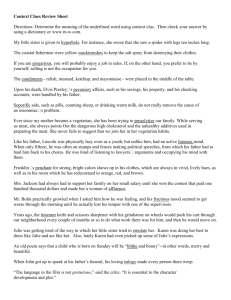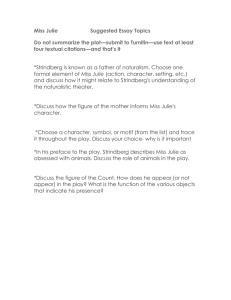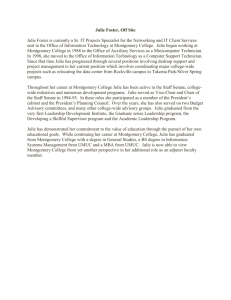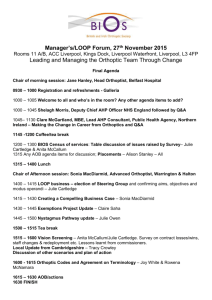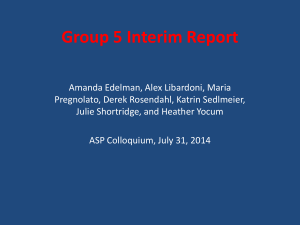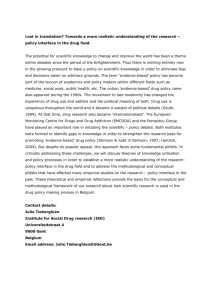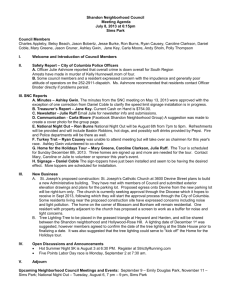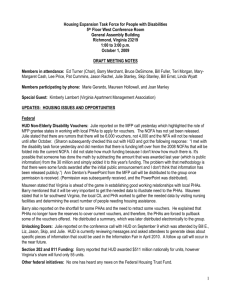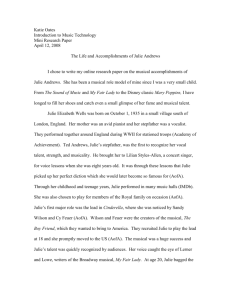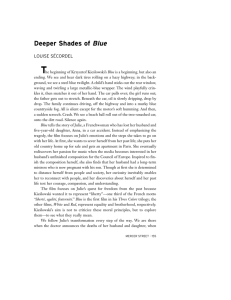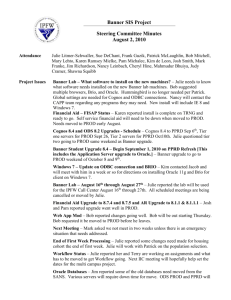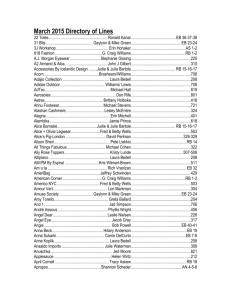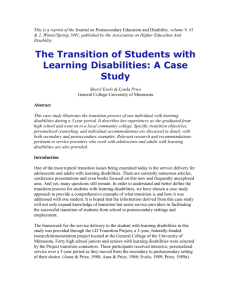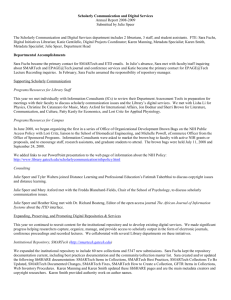THE ART OF DIAGNOSIS - University of Virginia
advertisement
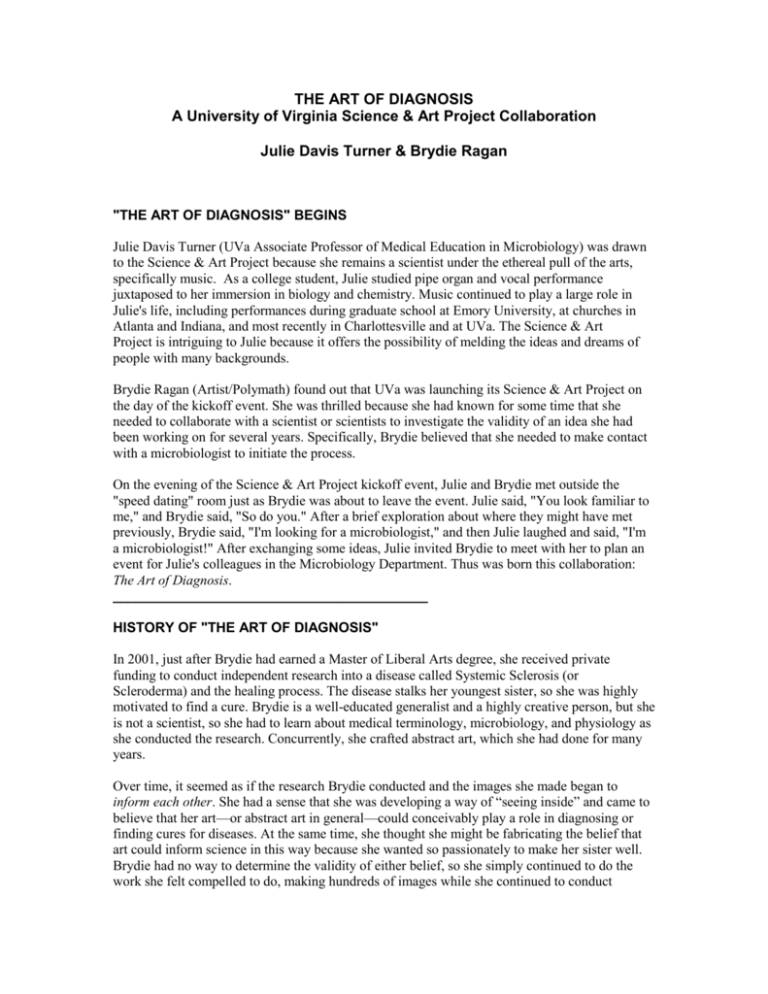
THE ART OF DIAGNOSIS A University of Virginia Science & Art Project Collaboration Julie Davis Turner & Brydie Ragan "THE ART OF DIAGNOSIS" BEGINS Julie Davis Turner (UVa Associate Professor of Medical Education in Microbiology) was drawn to the Science & Art Project because she remains a scientist under the ethereal pull of the arts, specifically music. As a college student, Julie studied pipe organ and vocal performance juxtaposed to her immersion in biology and chemistry. Music continued to play a large role in Julie's life, including performances during graduate school at Emory University, at churches in Atlanta and Indiana, and most recently in Charlottesville and at UVa. The Science & Art Project is intriguing to Julie because it offers the possibility of melding the ideas and dreams of people with many backgrounds. Brydie Ragan (Artist/Polymath) found out that UVa was launching its Science & Art Project on the day of the kickoff event. She was thrilled because she had known for some time that she needed to collaborate with a scientist or scientists to investigate the validity of an idea she had been working on for several years. Specifically, Brydie believed that she needed to make contact with a microbiologist to initiate the process. On the evening of the Science & Art Project kickoff event, Julie and Brydie met outside the "speed dating" room just as Brydie was about to leave the event. Julie said, "You look familiar to me," and Brydie said, "So do you." After a brief exploration about where they might have met previously, Brydie said, "I'm looking for a microbiologist," and then Julie laughed and said, "I'm a microbiologist!" After exchanging some ideas, Julie invited Brydie to meet with her to plan an event for Julie's colleagues in the Microbiology Department. Thus was born this collaboration: The Art of Diagnosis. _________________________________________ HISTORY OF "THE ART OF DIAGNOSIS" In 2001, just after Brydie had earned a Master of Liberal Arts degree, she received private funding to conduct independent research into a disease called Systemic Sclerosis (or Scleroderma) and the healing process. The disease stalks her youngest sister, so she was highly motivated to find a cure. Brydie is a well-educated generalist and a highly creative person, but she is not a scientist, so she had to learn about medical terminology, microbiology, and physiology as she conducted the research. Concurrently, she crafted abstract art, which she had done for many years. Over time, it seemed as if the research Brydie conducted and the images she made began to inform each other. She had a sense that she was developing a way of “seeing inside” and came to believe that her art—or abstract art in general—could conceivably play a role in diagnosing or finding cures for diseases. At the same time, she thought she might be fabricating the belief that art could inform science in this way because she wanted so passionately to make her sister well. Brydie had no way to determine the validity of either belief, so she simply continued to do the work she felt compelled to do, making hundreds of images while she continued to conduct research into Systemic Sclerosis and the healing process, again and again nourishing the mantra that art contains critical, interior information. Each of the images in the series measures 3.5 x 3.5 inches. Eventually, Brydie found a book that led her to believe that she might, indeed, be apprehending reality: that art could conceivably be used to diagnose or find cures for diseases. The book (Ewing, William. Inside Information: Imaging the Human Body. New York: Fireside, 1996.) contains a stunningly beautiful collection of micrographs of the human body, including images of a macrophage engulfing an invader, red blood cells entering a capillary, and a nerve connecting with muscle fibers. In the book, William Ewing paraphrases Manfred Kage, a celebrated micrographer: Painters like Lyonel Feininger and Max Ernst, Kage maintains, were certainly trusting their intuitions when they worked, but they were also tapping into the fundamental principles of organic form. The abstract and semi-abstract world they and their fellowearly-twentieth century artists created bears an uncanny resemblance to the ‘microcosmos,’ as it has been called . . . It is as if the insights and visions of the artists, relying on intuition rather than evidence, seized upon an invisible reality which would only be confirmed, and charted, in the last quarter of the [twentieth] century, by scientists. After reading Inside Information, Brydie wanted to find out if there were any studies being conducted to determine if art could inform the processes of diagnosing or curing diseases. She found very little information about the topic, but a journal article in Pediatrics reinforced her belief in the possibility. (Stafstrom, CE, Rostasy, K, and Minster A. 2002. The usefulness of children's drawings in the diagnosis of headache. Pediatrics, 109: 460-72.) While The Art of Diagnosis is at the embryogenesis stage, Julie suggests such scientific inquiry illuminates the potential for cross-fertilization among the conceptual views of one suffering physical morbidity. So many questions arise when anticipating the breadth of such a project: Could adults be led to provide enlightened histories of their illnesses? Might diagnosticians use art to enable this interaction? What is the relatedness between the mind and body? Such questions bridge the chasm between the physical and the cognitive, between what is known and what is felt, between art and diagnosis. The concept of bringing abstractions into diagnostics speaks volumes regarding the freedom that both the clinician and the artist embody when living at their highest level of accomplishment. _________________________________________ PLANS FOR THE FUTURE Julie and Brydie have met with Tom Skalak, the University of Virginia's Vice President for Research, about planning an event that will include a brief presentation explaining the concept, an exhibit of the artwork, and a brainstorming session about research possibilities. Brydie has several ideas for general research related to the use of art for diagnosis and scientific research, and she also has a very particular hope: to collaborate with a scientist or scientists to examine the artwork of Paul Klee for clues that might lead to a cure for Systemic Sclerosis because he died of the disease. All images ©2009 by Brydie Ragan
